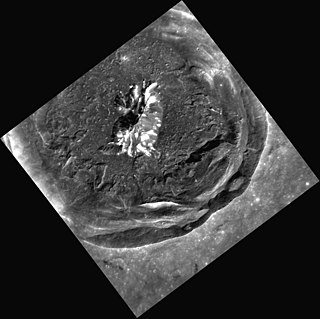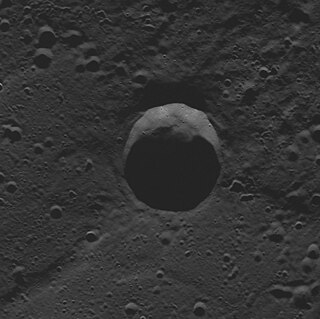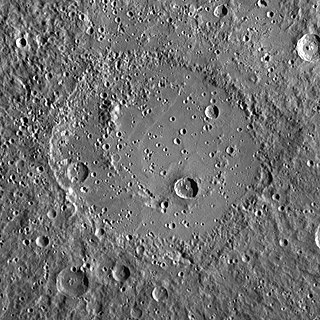
Matisse is an impact crater on the southern hemisphere of Mercury. Matisse takes its name from the French artist Henri Matisse, and it was named by the IAU in 1976.

Mozart is a crater on Mercury, named by the IAU in 1976 after Austrian composer Wolfgang Amadeus Mozart.

Eminescu is a peak ring crater on Mercury 125 kilometers (78 mi) in diameter. Since there are very few later craters superposed on it, Eminescu appears to be a young crater formed around one billion years ago. It has a transitional morphology between larger more complex impact basins like Raditladi and smaller simpler central peak craters.

Xiao Zhao crater is small in comparison with many other craters on Mercury. However, Xiao Zhao's long bright rays make it a readily visible feature. The fresh, bright rays, which were created by material ejected outward during the impact event that formed the crater, indicate that Xiao Zhao is a relatively young crater on Mercury's surface.

Atget crater is distinctive on the planet Mercury's surface due to its dark color. Atget crater is located within Caloris basin, near Apollodorus crater and Pantheon Fossae. The dark color of the floor of Atget is in contrast to other craters within Caloris basin that exhibit bright materials on their floors, such as the craters Kertész and Sander. Other craters on Mercury, such as Bashō and Neruda, have halos of dark material but the dark material does not cover the crater floors.

Cunningham is a young crater on the western floor of the Caloris Basin, on Mercury. It is surrounded by a bright ray system.

Amaral is a crater on the planet Mercury. With its smooth floor, surrounding ejecta, and small secondary craters, it appears noticeably younger than the heavily cratered surface around it. Along with a smooth crater floor, Amaral also has a central peak. Bright material on this peak is of particular interest as it appears to have an unusual color. In color-enhanced images, the central peak of Amaral appears as a bright blue color in striking contrast to the otherwise orange tones of surface material nearby. The different color of the central peak likely indicates rocks with different chemical composition from those on the neighboring surface.

Raditladi is a large impact crater on Mercury with a diameter of 263 km. Inside its peak ring there is a system of concentric extensional troughs (graben), which are rare surface features on Mercury. The floor of Raditladi is partially covered by relatively light smooth plains, which are thought to be a product of the effusive volcanism. The troughs may also have resulted from volcanic processes under the floor of Raditladi. The basin is relatively young, probably younger than one billion years, with only a few small impact craters on its floor and with well-preserved basin walls and peak-ring structure. It is one of 110 peak ring basins on Mercury.

Derain is a crater on Mercury named after André Derain, a French artist, painter, sculptor and co-founder of Fauvism with Henri Matisse. It has uncommonly dark material within and surrounding the crater. The material is darker than the neighboring terrain such that this crater is easily identified even in a distant global image of Mercury. The dark halo may be material with a mineralogical composition different from the majority of Mercury's visible surface. Craters with similar dark material on or near their rims were seen on the floor of the Caloris basin during MESSENGER’s first flyby.

Bartók is a crater on Mercury. Its name was adopted by the International Astronomical Union (IAU) in 1979. Bartók is named for the Hungarian composer Béla Bartók, who lived from 1881 to 1945.

Han Kan is a crater on Mercury. It has a diameter of 50 kilometers. Its name was adopted by the International Astronomical Union (IAU) in 1985. Han Kan is named for the Chinese painter Han Gan, who lived from 720 to 780.

Carolan is a crater on Mercury. Its name was suggested by an Irishman, Fergal Donnelly, and two Americans, Joseph Brusseau and Deane Morrison, in a naming contest which was eventually adopted by the International Astronomical Union (IAU) on 2015. Carolan is named for the Irish composer and performer Turlough O'Carolan, who lived from 1670 to 1738 C.E. The craters Kulthum, Enheduanna, Karsh, and Rivera were also named as part of the contest.

Ellington is a crater on Mercury named after Duke Ellington, an American composer, pianist, and leader of a jazz orchestra. It was named by the IAU in 2012.

Tyagaraja is a crater on Mercury. Its name was adopted by the International Astronomical Union in 1976. Tyagaraja is named for the Indian composer Tyagaraja.

Alver is a crater on Mercury. It has a diameter of 151.49 kilometers. Its name was adopted by the International Astronomical Union (IAU) on March 15, 2013. Alver is named for the Estonian poet Betti Alver.

David is a small crater on Mercury, which has a bright ray system. Its name was adopted by the International Astronomical Union (IAU) in 2013. David is named for the French painter Jacques-Louis David.

Rustaveli is a crater on Mercury. Its name was adopted by the International Astronomical Union in 2012, after the Georgian poet Shota Rustaveli.
Hollows are a landform on the planet Mercury, discovered during the MESSENGER mission that orbited the planet from 2011 to 2015.

Zmija Facula is a bright region on the surface of Mercury, located within an unnamed crater that is itself within the larger Rembrandt basin. It was named by the IAU in June 2020. Zmija is the Serbian word for snake.

Kofi is a crater on Mercury. It has a diameter of 136 kilometres. Its name was adopted by the International Astronomical Union (IAU) on April 24, 2012. Kofi is named for the Ghanaian sculptor Vincent Kofi.





















